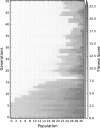Improving Robot Motor Learning with Negatively Valenced Reinforcement Signals
- PMID: 28420976
- PMCID: PMC5376586
- DOI: 10.3389/fnbot.2017.00010
Improving Robot Motor Learning with Negatively Valenced Reinforcement Signals
Abstract
Both nociception and punishment signals have been used in robotics. However, the potential for using these negatively valenced types of reinforcement learning signals for robot learning has not been exploited in detail yet. Nociceptive signals are primarily used as triggers of preprogrammed action sequences. Punishment signals are typically disembodied, i.e., with no or little relation to the agent-intrinsic limitations, and they are often used to impose behavioral constraints. Here, we provide an alternative approach for nociceptive signals as drivers of learning rather than simple triggers of preprogrammed behavior. Explicitly, we use nociception to expand the state space while we use punishment as a negative reinforcement learning signal. We compare the performance-in terms of task error, the amount of perceived nociception, and length of learned action sequences-of different neural networks imbued with punishment-based reinforcement signals for inverse kinematic learning. We contrast the performance of a version of the neural network that receives nociceptive inputs to that without such a process. Furthermore, we provide evidence that nociception can improve learning-making the algorithm more robust against network initializations-as well as behavioral performance by reducing the task error, perceived nociception, and length of learned action sequences. Moreover, we provide evidence that punishment, at least as typically used within reinforcement learning applications, may be detrimental in all relevant metrics.
Keywords: inverse kinematics; nociception; punishment; reinforcement learning; self-protective mechanisms.
Figures






Similar articles
-
Modular deep reinforcement learning from reward and punishment for robot navigation.Neural Netw. 2021 Mar;135:115-126. doi: 10.1016/j.neunet.2020.12.001. Epub 2020 Dec 8. Neural Netw. 2021. PMID: 33383526
-
Neural mechanisms of reinforcement learning in unmedicated patients with major depressive disorder.Brain. 2017 Apr 1;140(4):1147-1157. doi: 10.1093/brain/awx025. Brain. 2017. PMID: 28334960
-
Goal-directed autonomous navigation of mobile robot based on the principle of neuromodulation.Network. 2019 Feb-Nov;30(1-4):79-106. doi: 10.1080/0954898X.2019.1668575. Epub 2019 Sep 30. Network. 2019. PMID: 31564179
-
Multi-Agent Deep Reinforcement Learning for Multi-Robot Applications: A Survey.Sensors (Basel). 2023 Mar 30;23(7):3625. doi: 10.3390/s23073625. Sensors (Basel). 2023. PMID: 37050685 Free PMC article. Review.
-
Reinforcement learning and Tourette syndrome.Int Rev Neurobiol. 2013;112:131-53. doi: 10.1016/B978-0-12-411546-0.00005-6. Int Rev Neurobiol. 2013. PMID: 24295620 Review.
Cited by
-
Neurorobotics-A Thriving Community and a Promising Pathway Toward Intelligent Cognitive Robots.Front Neurorobot. 2018 Jul 16;12:42. doi: 10.3389/fnbot.2018.00042. eCollection 2018. Front Neurorobot. 2018. PMID: 30061820 Free PMC article.
-
Editorial: Cognitive inspired aspects of robot learning.Front Neurorobot. 2023 Aug 24;17:1256788. doi: 10.3389/fnbot.2023.1256788. eCollection 2023. Front Neurorobot. 2023. PMID: 37692887 Free PMC article. No abstract available.
References
-
- Akayama S., Matsunaga N., Kawaji S. (2006). “Experimental analysis and modeling of superficial pain on upper limb,” in International Joint Conference SICE-ICASE (Busan, South Korea: IEEE), 2891–2894.
-
- Balkenius C., Winberg S. (2008). “Fast learning in an actor-critic architecture with reward and punishment,” in Scandinavian Conference on Artificial Intelligence: (SCAI), Volume 173 of Frontiers in Artificial Intelligence and Applications (Stockholm, Sweden: IOS Press), 20–27.
-
- Blessing W. W., Benarroch E. E. (2012). “Lower brainstem regulation of visceral, cardiovascular, and respiratory function,” in The Human Nervous System, Volume VI: Systems, 3rd Edn, Chap. 29, eds Mai J. K., Paxinos G. (San Diego: Academic Press; ), 1058–1073.
LinkOut - more resources
Full Text Sources
Other Literature Sources

